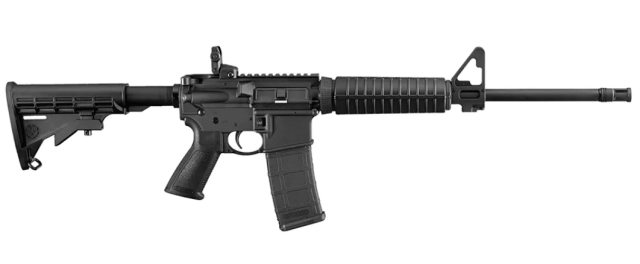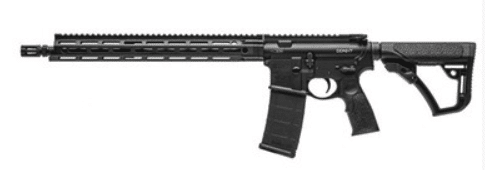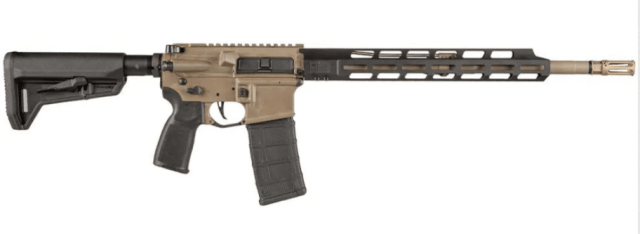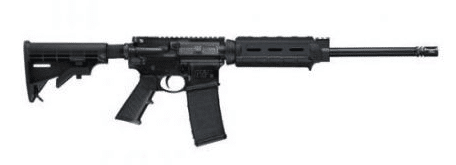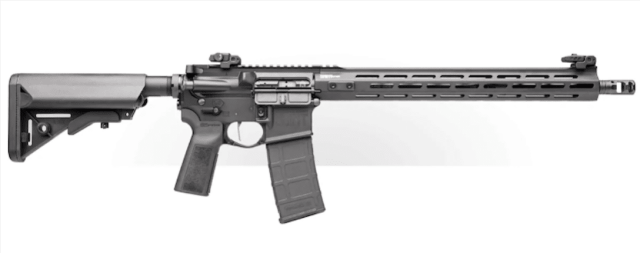Looking to buy your first AR-15 rifle but not quite sure where to start? Stay tuned, because in this article we’re going to cover the best AR-15 rifles, for budget shoppers and advanced shooters alike.
After you read this guide, you will have a pretty good idea how the AR-15 works and how different AR set ups make a big difference. This should help you make an informed decision on which AR-15 to purchase for your intended purpose.
Below, you will find our recommendations. To note, we spent days test firing these AR-15s and doing research to come up with this list..
Here’s Gun News Daily’s list of top ten AR-15 rifles across all price points:
American Tactical Imports : AR-15
Bravo Company: Mod 0, Mod 2, Recce 14/16
Rock River Arms: LAR-15 Entry Tactical
Smith & Wesson: M&P15 Sport II
Springfield Armory: Saint Victor 556
If you need to jump to a specific section of the article, please click on the link in the Table of Contents here:
GND Content Summary
Get Great Guns and Ammo Deals!
We will go into depth on the AR-15 and each AR we suggest throughout this article, but if you want to jump right into pricing and shopping here is a quick table of our best AR picks.
Why the AR-15 is Popular?
The AR-15 rifle is popular because of its versatility, accuracy, and ease of use. It is lightweight and has low recoil, making it a great choice for target shooting, hunting, and even home defense.
In addition, the modular design of the AR-15 allows for customization and a variety of accessories. The rifle is also relatively affordable and widely available.
There are many reasons why the AR-15 has remained the most popular of all civilian rifles. Here is a list of the top five reasons why I think they are so popular:
They are used by the U.S. Military
Does the military use the AR-15? Technically, no they don’t. The US military uses the M4 whereas civilians are legally allowed to only use the semi-auto AR-15. This differs from the automatic/select fire capabilities of the military variety.
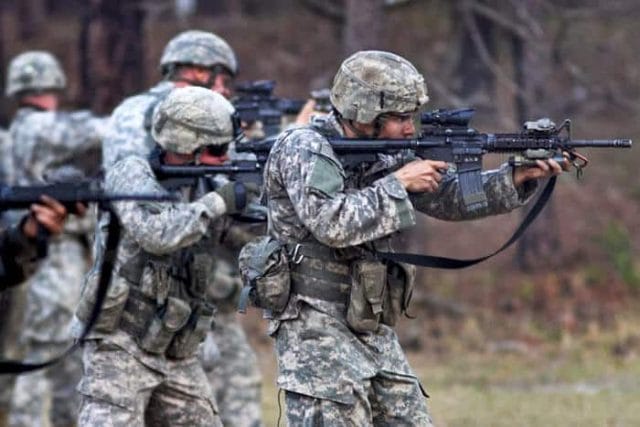
What does “AR” in an AR-15 stand for?
The AR in AR-15 stands for ArmaLite Rifle. Contrary to popular belief, AR does not stand for “Assault Rifle”. Armalite was the original manufacturer of the weapon. ArmaLite would go on to sell the design of the rifle to Colt in 1959. Today the term AR-15 is used to describe rifles of similar configurations from a myriad of different manufacturers.
What does Semi-Auto mean?
In a nutshell, semi-auto means with each pull of the gun’s trigger, only a single round is fired. This makes the AR-15 significantly slower to shoot compared to the military version of the rifle, the M4, which fires has a 3-shot burst option (three rounds are fired with a single pull of the trigger) and a full auto option (the gun will empty the entire mag if the user doesn’t let go of the trigger).
Personally, I prefer firing any gun in semi-auto. When doing target practice, I get to focus on each shot and don’t end up wasting bullets.
In real-life home defense scenarios where most of us only have to deal with one or two people, the ballistic performance of the 5.56×45mm caliber should be plenty powerful — a single shot should be enough to repel, maim or even kill a bad guy if needed.
Customizing an AR-15 with “Furniture”
One of the best things about the AR-15 is that it can be customized to suit aesthetic taste and home/personal defense needs. It is customizable for any purpose and has readily swappable parts, aka “furniture.” We have written an article dedicated to customizing your AR 15.
You can pick up practically any gun-related magazine and you will see ad after ad of aftermarket AR-15 accessories and parts.
To really put this into perspective, Brownell’s has a catalog of AR-15 parts that rivals the Yellow Pages in size, and Brownell’s is just one of many. That’s how readily available AR-15 aftermarket parts and accessories are.
AR 15 – Shootability
The AR-15 as a shooting platform has relatively more manageable recoil compared to other rifle platforms, particularly so when chambered in its intended 5.56x45mm round. It is also offers relatively better ergonomics than other popular rifles, such as the venerable AK-47.
It is a precision-built tool specially designed for accuracy with some models tricked out with easy-grip hand guards, scope mounts and more. This is why many rifle purists and even hunters swear by the AR-15.
And this brings us to number four our my list of reasons why the AR-15 is incredibly popular.
AR 15 – Modular Design
The AR-15 is primarily comprised of two segments—the lower receiver and the upper receiver, each of which can be easily swapped out in as fast as a few seconds, provided the user has put enough time to practice field stripping and reassembly.
I’ve seen a few people assemble an AR real fast even when blindfolded.
This modularity makes the AR-15 stand out as a weapon platform: it’s easy to clean, easy to maintain, easy to field strip and easy to reassemble.

This also makes it versatile because in a pinch, with the right parts and accessories, it can be configured as a DMR (Designated Marksman’s Rifle) high-precision rifle, a hunting rifle (using bigger caliber barrels and ammo) or by default, as a CQB (Close Quarters Combat) carbine by simply switching out the upper receivers and barrels.
AR 15 Versatility
What’s more, the upper receiver and barrel can be swapped out for a ton of different calibers like the significantly weak but plentiful .22LR or the monstrosity that is the .50 Beowulf.
If you’ve never heard of the .50 Beowulf, it’s essentially a 50-caliber round that has the same ballistic performance as that of the most powerful production revolver caliber, the .500 S&W Magnum, designed primarily for big game hunting.
Only difference between the two is firing the .50 Beowulf in a rifle platform is significantly more manageable than firing the .500 S&W Magnum in the wrist-breaking S&W 500 X-frame revolver — that, and you get more rounds in the mag with the AR-15 compared to only five shots in the X-frame revolver’s cylinder.
As mentioned earlier, there is no end to the aftermarket products with which the AR-15 can be customized to suit anyone’s specific preferences and needs. The sky’s the limit when personalizing the look, feel and performance of your rifle, provided you have the money to burn.
People make fun of some AR-15 enthusiasts who like to pimp their gun, overly customizing it to impractical tacticool levels, but I say to each his own. It’s your hard-earned dollar, don’t let anyone tell you how you should be spending it.
AR15 Rifle Demand
If someone tells you that you can’t have something, you end up wanting it that much more.
That was the case with the AR-15 back when then-POTUS Bill Clinton signed into Office the 1994 Assault Weapons Ban.

In time, Clinton would come to realize that his ban did nothing to deter gun-related crimes nor did the ban successfully halt production on AR rifles. But it did cause AR sales to rise and, also, resulted in manufacturers making innovative modifications to the AR model to strengthen its materials.
Fast forward to the present, the demand resulting from the Clinton ban didn’t die. In fact it’s gotten even stronger — proof being every day there seems to be a new firearms manufacturing company selling their version of the AR-15.
And since more and more of them are being made available, pricing is never going to be an issue
The Origins of the AR-15
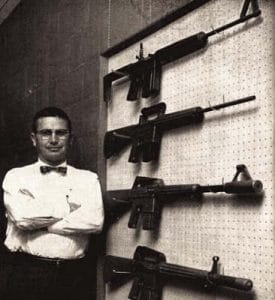
The first AR-15 was manufactured in 1958 by Eugene Stoner for ArmaLite (which is why it’s a no-brainer that ArmaLite should land on this list). It was a lightweight 5.56x45mm variation on the 7.62x51mm AR-10.
The lighter bullets made it so that infantrymen could carry more rounds with ease.
Most people associate the AR-15 with the Colt name because Armalite sold the rights to Colt in 1959. But think about the name AR-15 — what does the AR stand for?
If no one ever told you, the AR is short for Armalite (not “Assault Rifle” as so many folks in the media would lead you to believe.)
Over time, Colt tweaked the design and came out with the M16, a select fire (auto) design with a twenty-inch barrel.
In the 90’s, the M4 was introduced featuring a 14.5-in barrel and a carbine gas system. Carbine is a word that basically serves as a shorthand for “shorter barrel.”
The AR-15 is the civilian semi-auto version of the fully-automatic M4. To reiterate what was said earlier about semi-autos, one pull of the trigger equals one shot.
Since Colt owns the rights to the AR-15 name most manufacturers use slight variations on the name such as ARX, A4 or, more cleverly, “PredatAR.”
Now, to answer a pressing question:
AR-15: To Build or Buy?
For those of you who are purchasing your first ever AR-15, I would highly advise you buy a complete rifle from a trusted manufacturer. In the very least, you should buy a total upper and customize your own lower.
This will prevent a lot of inconveniences because you will have a full warranty on your rifle. Also, when you’re just getting started, you might not know exactly what you want or need so it’s best to go with a standard configuration.
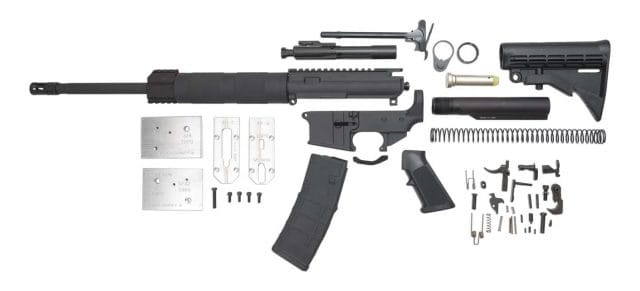
Factory-grade rifles are generally pretty affordable which means that you won’t have to spend much more than you would if you were building your own. Besides, beginners aren’t exactly adept at assembling their own firearm so this takes the headache out of the whole process.
Another factor here is resale value. As I learned the hard way when I posted an ad in the past, self-built rifles are practically worth nothing when compared to branded pre-built firearms.
Frankengun AR 15
On the flip side, many people enjoy the sense of pride they get from building their own. Designing your very own “Frankengun” can be a satisfying and fun experience, but I recommend getting your hands on a standard AR before attempting to go the DIY route.
I think you’ll have an easier time building one after you’ve spent some time with a factory gun.
For those who have graduated from the factory-built AR-15 and want to build your own AR-15 lower receiver, there are several resources out there that will walk you through the process.
I recommend this helpful and informative YouTube video, which covers the process start to finish.
AR 15 – Barrels
This is another important area that needs to be covered, especially for first-time shooters. We’ll begin by breaking down the AR-15 system by talking about the multiple characteristics of barrels.
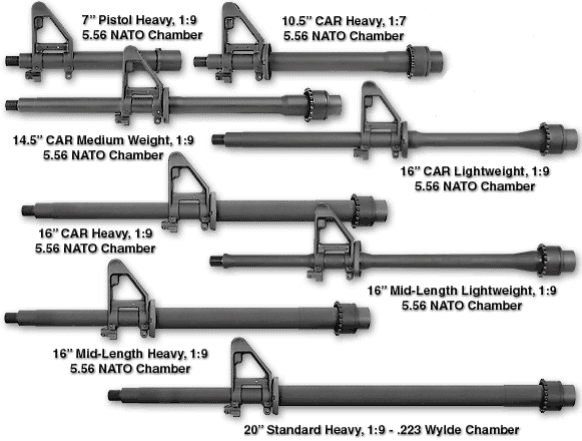
This can be boring or fun depending on your level of familiarity with the platform.
Barrel Chamber
The chamber is that part of the barrel where the cartridge resides before it is fired. This, and the barrel itself, determine what kind of ammo your rifle can shoot.
For beginners, you’ll want to focus only on the most common loads— the .223 Remington and the 5.56X45 mm. As mentioned earlier, there are lots of rifle calibers available for the AR-15, from the lowly .22LR to the powerful .50 Beowulf, but the .223 Remington and the 5.56X45 mm are the two best offerings for novices.
The 5.56mm is the most popular choice for home defense and fun plinking sessions. It is readily available so ammo is cheap.
Now this might seem like a no-brainer but when it comes to guns, safety should always be a top priority. With that in mind, here are some guidelines first-time AR-15 owners have to remember:
- With a .223 barrel, you can only fire .223 rounds.
- Hybrid chambers like Wylde are implemented for specific reasons but can fire a .223 or a 5.56.
- The 5.56 barrel, on the other hand, can fire both 5.56mm AND .223 Remington
- Always clean and lube before shooting, especially if your rifle is new.
- Always protect your eyes and ears with goggles and ear plugs
- Consider taking shooting lessons/classes before purchasing an AR-15.
Barrel Length
The minimum barrel length, according to Federal law, is sixteen inches. If an additional device is used, such as a muzzle brake or flash hider, it has to be permanently attached if it will be included in the rifle’s length.
For instance, gun owners can have a 14.5-inch barrel and weld a muzzle device that’s 1.5-inch long in order for the gun to be compliant with Federal requirements.
However, it is important to note that some states and municipalities have their own laws governing firearms and their accessories, so be sure to familiarize yourself with the rules and regulations in your area.
Due to these restrictions, we strongly advise first-time shooters to purchase at least a sixteen-inch barrel so that they can swap out muzzle devices at will. There are three main lengths that are popular: 16”, 18” and 20”.
One thing that beginners should be aware of is the length of an AR-15’s barrel doesn’t necessarily equate to accuracy. Anyone who knows that they’re doing can achieve plenty of accuracy with a sixteen-inch barrel because it is stiffer and thus less affected by barrel whip.

On the other hand, longer barrels can provide higher velocities as there is more space for the powder to burn and more room for the bullet to accelerate.
Faster Bullets Mean
When bullets are able to move faster, there is far less time for environmental factors to affect the bullet’s trajectory (e.g. wind and gravity), meaning that each shot will be relatively more powerful and a bit more accurate over longer distances.
On average, sixteen-inch barrels are able to reach a target from four hundred yards away. That being said, the traditional fifty-five grain load grows more imprecise after three hundred yards, so fire carefully.
If you’re looking to fire at a longer range, you would fare better with a heavier, longer load like a sixty-two grain, seventy-seven or eighty grain bullet.
When I’m considering a weapon of any kind, I always think about portability. Shorter barrels generally weigh less and are easier to handle.
AR 15 Barrel Material
When you first get into guns, it can be overwhelming. There are so many numbers and so much technical jargon that it might seem scary or confusing.
This is especially true of barrel material which is why I’ve tried my best to simplify it for the newbies out there who are just learning about this stuff.
- 4140: This consists of steel with ten percent less carbon compared to its predecessor, 4150 steel.
- 4150: Steel used in mil-spec barrels.
- Stainless Steel: This one is more accurate but isn’t as durable as 4150 or 4140 steel.
- Chrome Molybdenum Vanadium, Chrome Moly, or CMV: Basically identical to 4140
There are slight differences between that last one and 4140. Chrome Molybdenum Vanadium steel alloy contains a range of elements from chromium and nickel to molybdenum and so forth. It is renowned for its strength and hardness.

“Chrome Moly” or Chromium-molybdenum steel, is a range of low alloy steels that are of high tensile strength and aren’t as lightweight as counterparts like aluminum.
4140 alloy steel is a combination of chromium, molybdenum and manganese has high fatigue strength, impact and abrasion.
Both are high tensile strength steels which make them great for guns as well as bicycles and the like.
The average shooter should probably just stick with 4140 or CMV because there’s really no benefit to using 4150 unless you’re dealing with a fully-automatic piece. Besides, you’ll save money as 4150 costs more.
Barrel Lining
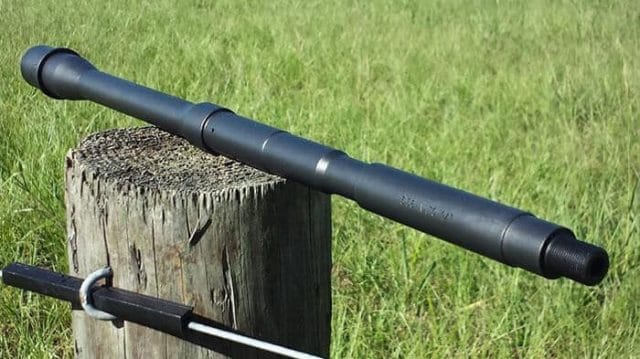
There are three basic options on the market when it comes to the inside of your AR-15 barrel. They are as follows:
- Ferritic Nitrocarburizing (FNC): Otherwise referred to as Melonite, Tennifer or Nitride, FNC treats the surface of the barrel instead of just coating. This can result to increased accuracy.
- Chrome Lined: A popular form of barrel lining. It is a coating that makes for better barrel longevity, but that longevity comes at a price — accuracy might suffer. If either end of the barrel has a gray ring around it, it’s chrome lined.
- None: Some barrels have absolutely no coating whatsoever.
Many environmental factors such as heat, moisture and more can affect your exact round count, but you can count on approximately ten to twenty thousand rounds before you need to re-barrel.
If you’re still with me, let’s move on to testing, another important area to be aware of.
AR 15 Barrel Testing
As I said before, there is a lot of technical mumbo jumbo that comes with owning guns. Some acronyms that manufacturers like to throw at you include the following:
- MP: Magnetic Particle tested. This just means that it’s essentially subjected to X-Rays to check that the gun doesn’t have any voids, cracks or other imperfections.
- HP: High Pressure tested. This is a method by which manufacturers ensure the integrity of anything from primers and projectile seating depth to chamber parameters and neck tension.
Of course, some AR-15s have not been tested at all, so buyer beware! If a gun’s packaging or advertising specifically says it hasn’t been tested or doesn’t mention testing, you’re buying it at your own risk.
Barrel Forging

- Cold, Hammer, Forged (CHF): This is a process that results in a more durable barrel. Repeated blows by a series of hammers align the grain within the metal, causing more strength and rigidity.
- Barrel, Forged, Hammer (BFH): Essentially the same as CHF, BFH is where a mandrel (carbide tube) is inserted into the barrel, rotated and pushed forward to create precise rifling.
With these options, you lose some accuracy but they make up for that with increased durability.
Barrel Contours
This refers to the thickness and overall shape of your barrel. Fortunately, there are several options available.

They include:
- CAR (Colt Automatic Rifle): This one used to be the name of a certain group of AR-15s and M-16s back in the 1970s, but today it is a name for carbine-length rifles.
- Light: This one is just what it sounds like, it’s lighter than others but it’s vulnerable to the heat associated with rapid firing. This one’s .625-in in diameter.
- Heavy (Bull): This one is heavier and stiffer, but it’s also far more accurate. I like this one a lot because it can handle more heat than others before it starts to be affected. It’s typically implemented for precision builds. Bulls are .936” in diameter.
- Medium (M4): The M4 contour possesses a cutout for grenade launchers which is what makes it ideal for military purposes. It’s got terrific balance and is .750” in diameter.
In my opinion, the average plinker doesn’t require anything more advanced than light or medium barrel.
Barrel Feed Ramp
This is a vital part of the AR-15’s upper receiver, therefore you want it to properly match the barrel of your rifle.
It is still debatable as to whether or not the barrel’s feed ramp affects reliability, but at the very least, it’s important to match the ramp with the upper receiver. Usually, if you buy factory made rifles this won’t be an issue, but you should still check to confirm it.
AR-15 Gas Systems
Now that you know the basics of the AR-15, we’ll get into more complicated stuff.
There are two primary types of gas systems for the AR-15. They are DI and Piston. DI stands for Direct Impingement. DI is the original design whereas the Piston only became popular in recent years.
Direct Impingement vs Piston
The AR-15 operates by transmitting hot gas behind the bullet into the gas tube at which point it the gas tube uses the gas to either move a piston or deliver the gas directly back (direct impingement).
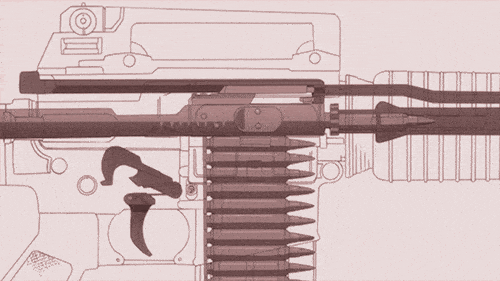
No matter how the force is applied, it makes the bolt unlock, move back, eject the spent casing and push a new cartridge into the chamber.
By and large, most AR-15s are DI instead of Piston. Like most things, there are pros and cons to each.
Pros of Piston
- Typically more reliable in poor weather conditions (dust, water, moisture, heat, et al.)
- Relatively cleaner as dirty gas is vented out
Cons of Piston
- More expensive than DI
- Heavier with more weight in front
- Harder to find proprietary parts from manufacturers
- Less accurate than DI
Unless you’re in an Arnold Schwartzenegger movie where you have to fire your weapon coming out of water or you live in a desert somewhere, a DI system will be perfectly adequate for most purposes.
Assuming you properly maintain your AR-15, a DI model will be a dependable weapon.
DI Gas System Lengths
Gas system length is the distance to the gas hole. The gas hole refers to the triangular front site base (FSB) that sits on top of the barrel.
Although there is the rare “Dissipator” model that has a sixteen-inch barrel, the rifle length gas system is normally used for an eighteen-inch barrel.
The average choice for sixteen-inch barrels is a carbine or midlength gas system.
Personally, I favor the midlength system because I think it’s advantageous because it enables the user to have a longer sight radius when you’re using a front sight base. You also get more rail space because the handguard extends from the upper receiver to that front sight base.
AR 15 Gas Blocks
We’ve mostly been talking about the FSB (Front Sight Base) style gas block here where the front sight is combined with the gas block and there’s a reason for that.
I always recommend this style to first-time shooters because it’s easier to have a front sight and it’s affordable to use a non-free-floating barrel.
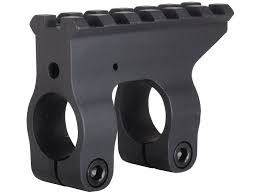
Another good thing about this style is that it can be converted by grinding down the front sight base to allow for a free-floating barrel.
AR 15 Handguards
Front sight blocks generally use non-free-floating handguards. So the two-piece handguard touches the barrel at the front sight base which, unfortunately, can add a bit of inconsistency when it comes to force. Consequently, your shooting accuracy can be affected.
Nevertheless, if you are a non-competitive shooter, the non-free-floater will be accurate enough.
While there are some aluminum models, most are made from polymer and are cheaper and just as good at more affordable price points.
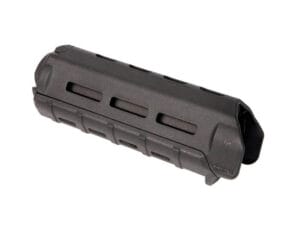
Magpul MOE handguards are our go-to handguards because they enable the shooter to attach Picatinny rails on slots which allow you to add accessories. Picatinny rails are a tad on the heavy side, but if you like to attach accessories, this is the way to go.
BCG (Bolt Carrier Group)
The BCG is basically the engine which runs the AR-15. It retracts when you pull the charging handle back.
When you let go of the handle, the bolt carrier group moves forward, strips a round from the mag and releases a round into the chamber.
When you pull the trigger, the hammer is released and it strikes the firing pin, hitting the the primer. This sparks the gunpowder, sending the bullet down the barrel. This is where the gas system comes into the picture.
The Best AR-15 Manufacturers
There are a number of other factors that you’ll want to consider when selecting your AR-15.
They include build (precision build or 18” barrel vs pistol build or short-barreled rifle), optics, trigger (single stage vs two stage trigger), rifle type (semi-auto vs full-auto), but for the sake of brevity, let’s get right down to it.
Below is a full list of all the top AR-15 manufacturers around followed by my personal favorites.
These are the manufacturers that seem to be reputable rifle vendors who don’t cut corners and commit to providing quality materials. Either that or they’ve just got a crazy marketing budget that makes them look boss.
Top Tier AR 15 Manufacturers
As of the publishing of this article, we vouch for the following eight companies as the absolute best manufacturers of AR15 rifles:
The companies listed above are believed to be the greatest sources for service grade AR-15s.
Mid-Tier AR 15 Manufacturers
These are some companies with good guns that are fine for training/range plinking purposes. I suggest you run at least 1,000 rounds through one of these rifles before you trust any of them with your life.
You want to know that your AR works before affording it the title of great home defense weapon.
Budget AR-15 Manufacturers
Don’t be thrown by the title, these are perfectly adequate manufacturers with perfectly good guns. They are inexpensive and may be the right choice for starter rifles.
AR-15 Price Points
When it comes to the top tier, you should be prepared to spend no less than $1,000. On the other hand, most mid-tier manufacturers’ rifles start at $500.
$1,000 might sound steep, but keep in mind that you’re paying for quality, name, and the research and development that goes into the same.
Our Top Picks for AR-15 Rifles (Updated: 2022)
Let’s talk a bit about my top picks! To recap, here’s my top ten list across all price points:
I’d just like to preface this by saying that if a popular AR-15 isn’t on this list, it doesn’t mean that the rifle is no good. This is just based on our own tests.
1. Ruger AR-556
Since its introduction back in 2014, the Ruger AR-556 has firmly established itself in the AR-15 market as one of the best budget ARs available. The AR-556 is a more inexpensive variant of the SR-556 series of rifles. The primary difference is that the AR-556 is a direct impingement weapon, and the SR-556 is piston driven.
The AR-556 comes coated in a matte black oxide finish for excellent rust and corrosion resistance. It comes standard with a 16 inch barrel that is cold hammer forged with ultra precise rifling for both longevity and excellent accuracy.
The handguards over the barrel and gas tube are built out of a glass filled nylon and are very heat resistant so they can withstand repeated firing. The M4-style synthetic buttstock is easily adjustable with six different positions offered.
Additional features include a forward assist, dust cover, brass deflector, an elevation adjustable fixed front sight, and a Ruger flip up rear sights. The Ar-556 also ships with a front sight tool and a 30 round Magpul PMAG.
2. American Tactical Imports, AR-15
Another good option for a budget AR-15 carbine is the American Tactical Imports AR-15 Milsport Ria. This is a mil-spec M4-style AR-15 that comes with a 16 inch M4-profile barrel with a 1:8 twist rate. A flash hider is threaded onto the end of the 5/8×32 TPI muzzle.
The lower and upper receivers are built out of forged 7075 aircraft grade aluminum. As a mil-spec AR-15, an A2 handguard and collapsible synthetic stock are also installed on the rifle.
This is also an optics ready AR-15, meaning that it is ready for you to add a red dot or scope to the Picatinny rail on the top of the receiver. There are no sights on the rifle, so you will need to add those yourself if you so desire as well (such as the Magpul flip up sights).
3. Bravo Company Mod 0,
All three options are worth looking into, but we like the Mod 0 more because we’ve spent more time with it than others. The Mod 0 is a 16” 5.56x45mm rifle that typically goes for around $1,600.
With a chrome lined barrel, the Mod 0 was not designed for the gamer, rather it is geared toward tactical applications. But when it comes to training and range shooting, this one packs a lot of punch.
This one includes the aforementioned Magpul MOE handguards and a PNT trigger. For me, it’s the gold standard of modern AR-15s.
The Mod 2 is a quarter of an inch wider than the Mod 0 and shares its cable lock and 5.56mm chambering. It’s also got a mid-length gas system that enables it to run cooler than its counterparts.
The Recce 14/16 is more pricey than the others on this list, generally retailing for $1,500. But it’s a beautiful, streamlined weapon that will definitely be the envy of everyone you encounter at the gun range. The first time I picked one up, I felt like I was in a Predator movie. Seriously, just look at this design:
As with the Mod 0 and Mod 2, the Recce 14 is a 5.56mm caliber rifle with a chrome lined barrel and 11595E certified steel. It’s got a Mod 4 charging handle, a Mod 3 pistol grip and a BCM QD end plate.
With a shot peened bolt, feed ramp flat top receiver and chrome lined bore and chamber, it’s a real beast.
4. Wilson Combat – AR-15
Even though Wilson Combat is most well-known for their 1911 pistols, they have been making headway into the AR market over the last couple of years too. This is a match-grade AR-15 that comes with a precision rifled barrel built out of stainless steel. The end of the barrel features a Q-Comp muzzle device that does an excellent job of both reducing recoil and the amount of blast that is sent back to the shooter upon firing.
The 2-stage tactical trigger from Wilson is incredibly crisp, and has a modular construction design that makes it easy to takedown as well. The carbine also utilizes a mid-length gas system, which Wilson claims helps lend itself to superior reliability.
Additional features of the Wilson Combat Protector worth noting include the BCM pistol grip, high quality aluminum tactical trigger guard, low profile gas block, M-Lok compatible hand-guard, QD sling mounts, and mil-spec grade upper and lower receivers.
5. Daniel Defense – DDM4 V7
Daniel Defense is one of the biggest names in the AR world, and they are widely regarded as manufacturing some of the highest quality ARs on the market. The DDM4 V7 features M-Lok attachment technology on the DD MFR XS Rail.
The carbine-length 16 inch barrel is cold hammer forged and comes with a flash hider threaded onto the end of the barrel. Despite this being a carbine, Daniel Defense utilized a mid-length gas system for superior reliability.
An uninterrupted M1913-style Picatinny rail runs along the top of the free floating MFR XS handguard, with no less than seven M-LOK attachment points. In other words, you have a variety of options for adding sights, accessories, and optics. Meanwhile, the carbine also comes installed with Daniel Defense’s trademark pistol grip and stock.
6. LaRue Tactical PredatAR
We mentioned the Predator movie earlier, right? Well, for those who liked that movie, you’ll appreciate the name of this LaRue model, and it wouldn’t look out of place in a balls-to-the-wall action movie like Predator either.
This one’s got a camo-colored stock, a fierce-looking barrel and all the things anyone could want in an AR-15. It’s got lightweight maneuverability, sub-MOA accuracy and staked carrier keys.
7. Rock River Arms LAR-15 Tactical
At $800-1,000, this is middle of the road expensive AR-15s on this list, and for good reason.
Most people have never heard of the Rock River Arms brand of AR-15 — they’re currently not as popular as the most established brands we grew up hearing, e.g. names like Remington, Smith & Wesson, Sig Sauer, etc.
Rock River Arms were founded in 1993. They have been steadily earning a solid reputation as an AR-15 manufacturer ever since.
With a hogue grip and A2 flash hider, the LAR-15 is comfortable to use, accurate and built to last. It’s got an RRA two-stage trigger and a star safety selector as well.
Although we can’t recommend this rifle to everyone seeing as how hard it can be on the wallet, being a feature-packed piece of hardware, it’s well worth the price — definitely worth taking a look at if you can afford it.
8. SIG Sauer M400
The M400 is billed as being made from some of the finest components and I’d definitely agree with the advertising. It’s got a handsome, classy titanium finish and a direct impingement system.
The thing that makes this the ideal piece for a newcomer to the AR-15 is its ROMEO5 red dot sight.
Though personally, I’m not a real fan of any sight system save for the classic run-of-the-mill iron sights that come pre-installed in most guns, the ROMEO5 sight it comes with will make a huge difference, especially for those who who prefer a red dot sight installed on their AR-15 out of the box.
And being manufactured by SIG Sauer, a company known for their firearms’ reliability, for $999.99 you are paying for the company’s reputation and experience. They wouldn’t have won the US Military’s Modular Handgun System contract if their guns aren’t top notch.
9. Smith & Wesson – M&P15 Sport II
The Smith & Wesson M&P15 Sport II is one of the most successful budget AR-15s on the market, and competes directly with the Ruger AR-556. The M&P style carbines are designed for tactical use and recreational sport shooting alike.
This particular M&P15 Carbine comes with an MOE M-LOK carbine length handguard and a picatinny-style M-LOK style rail panel. The 16-inch carbine length barrel has a 1:9 twist rate, and is coated in a very rust and corrosion resistant Armornite finish. The firing pin is chromed for superior durability and longevity.
Meanwhile, the M&P15 Sport II comes with a dust cover and a forward assist, two features that were originally lacking on the original M&P15 Sport model. A thirty round Magpul PMAG ships with each M&P15 Sport II carbine.
10. Springfield Armory – Saint Victor 5.56
The Springfield Armory Saint Victor is a new series of AR-15s in the Saint lineup that were introduced in 2019. A very lightweight carbine at just under seven pounds. The Saint Victor is most noted for its Accu-Tite tension bonded flat top forged upper receiver. The 16-inch carbine length barrel is built out of a nice Melonite finish that is very rust and corrosion resistant.
Meanwhile, the free floating 15-inch hand-guard shields both the barrel and the mid-length gas system. A muzzle brake on the end of the barrel helps to reduce both recoil and muzzle rise. The bolt carrier group is built out of a very durable 9310 steel. Spring loaded flip up sights also come installed on the rifle for rapid deployment. Both the upper and lower receivers are built out of a high quality aircraft grade aluminum.
Best AR-15 Rifles – Conclusion
We’ve gone over a ton of stuff here and it’s probably been exhausting, but if you’re only looking to purchase your first AR-15, we recommend that you do your own research before buying anything.
We also recommend for anyone who already owns an AR-15 to get a quality range bag to house their rig and also check out one of our recommended cleaning kits if they haven’t purchased one yet.
There are a host of great resources out there that give even more specific info about how to shoot an AR-15 properly. How to maintain them, and how some AR-15 models could be better for certain purposes than others.
It goes without saying that you, as the buyer, should make sure that the AR-15 you’re looking to buy will serve your intended purpose. The world of AR-15s is vast and we can only fit too much info on a single article. We can’t emphasize more how important it is to do your own research.
Love your AR15 but don’t see it included on my list? Please let me know in the comments below!
Recommended Reading
Best AR-15 Calibers And Cartridges
How To Build an AR-15 Upper Receiver
AR-15 Furniture and Accessories
Best Ammo, Caliber & Cartridges for AR-15



